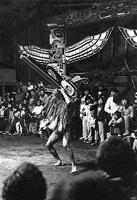Potlatch
POTLATCH is an important cultural event celebrated by most of the FIRST NATIONS of the Northwest Coast. The term comes from a NUU-CHAH-NULTH (Nootka) word borrowed into CHINOOK JARGON meaning "to give." The potlatch serves many purposes: to reinforce status in the community, to memorialize the dead, to celebrate a marriage or the construction of a house, to raise a TOTEM POLE, to name children and to pass on the heritable privileges and positions that go with chieftainship. The forms of the potlatch differ among the different coastal First Nations but in general a potlatch validates an individual's role in the community and establishes claims to names, privileges and social rank. This in turn validates the right to resources obtained from specific areas within the tribal territory. Traditionally, potlatch ceremonials were at the heart of First Nations governance and social structure. The event may last several days, during which time guests take part in feasting, speech-making, dancing and gift-giving. The distribution of gifts, which may have become more elaborate following contact with Europeans, affirms the host's wealth and status while at the same time recognizing the status of guests and honouring them for attending. Failing to understand its significance, governments and some missionaries blamed the potlatch for encouraging idleness and immorality, for squandering wealth and for hindering attempts to convert the First Nations people to Christianity. As a result, in 1884 the federal government banned the potlatch. Aboriginal groups resisted the law and authorities could do little to carry it out. In 1889 the first potlatcher was arrested but Chief Justice Matthew BEGBIE threw the case out of court and ruled that the law as written was unenforceable because it did not define "potlatch." The law was amended in 1895 but it continued to be enforced intermittently. The potlatch was driven underground where it continued in secrecy, especially among the KWAKWAKA'WAKW (Kwakiutl). For the most part authorities used persuasion rather than coercion in attempting to stamp out the ceremony. For a period following WWI, however, the government pursued the ban with special zeal, making several arrests. In Dec 1921 a Kwakwaka'wakw potlatch held by Dan Cranmer at VILLAGE ISLAND resulted in charges being laid against 49 people. In the end, 26 people were jailed. Ceremonial items surrendered as a result of the convictions ended up in the collections of the Canadian Museum of Civilization, the Royal Ontario Museum and the Museum of the American Indian in New York. Many of these items were returned to the coast in 1979–80 and are now on display at the Kwagiulth Museum at We Wai Kai (CAPE MUDGE) and the U'MISTA CULTURAL CENTRE in ALERT BAY. Traumatic as the suppression of 1921 was, it did not end the potlatch, which remained illegal until the ban was dropped from the revised Indian Act in 1951. With the revival of aboriginal cultural expression since the 1950s, the potlatch continues to be an important ceremony for coastal people.
Reading: Douglas Cole and Ira Chaikin, An Iron Hand Upon the People, 1990; Aldona Jonaitis, Chiefly Feasts: The Enduring Kwakiutl Potlatch, 1991.
-
Internet links

